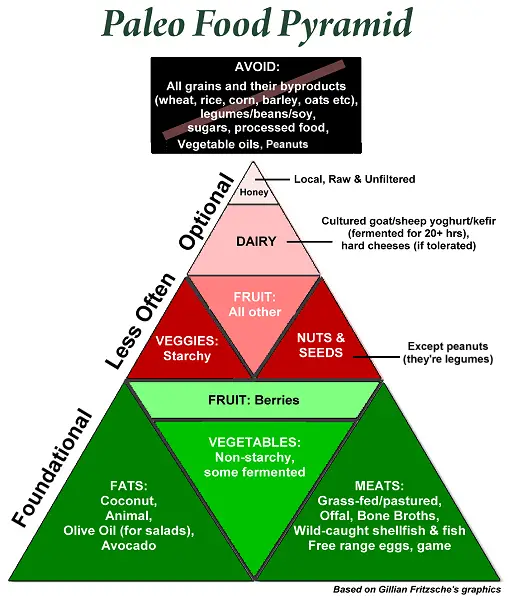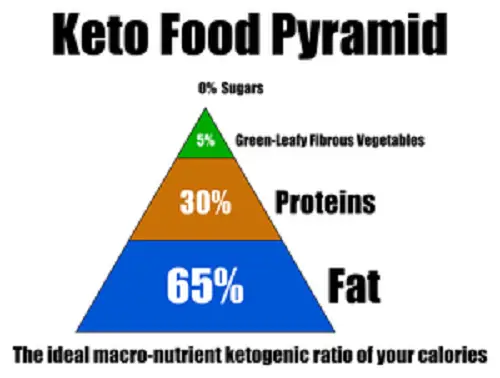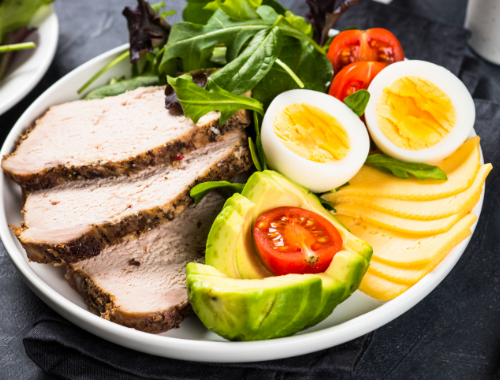What is Paleo?
The paleo diet is also referred to as the Paleolithic diet and is based on the notion that one should only consume foods that were available to people living during the Paleolithic era.
In the paleo diet you can eat fruits and vegetables but you should avoid all dairy, grains, legumes and any foods that are processed, since during the Paleolithic, food was of course not processed.
During the Paleolithic, humans were mainly hunters who hunted and ate animals. People at this time also gathered uncultivated plants to eat.
As a result the paleo diet is also often called the hunter-gatherer diet.
This diet advocates eating only non-starchy vegetables and in general, few carbohydrates. It is a low carbohydrate meal plan which advocates consuming relatively high levels of protein which should be in the form of lean meat.

Seeds and nuts can be eaten but not processed cereals, since seeds and nuts would have been available during the Paleolithic but not modern cereals.
Sugar and salt should be eliminated from the diet along with unhealthy fats such as butter or margarine. Trans fats should also be eliminated from the diet.
Healthy oils such as olive oil are recommended. Fish can be eaten as they contain healthy omega-3 fatty acids.
The paleo diet has shown some benefit to people who have metabolic syndrome, probably because the diet does not allow for processed foods or sugar, the intake of which seems to contribute to people developing metabolic syndrome.
Metabolic syndrome is a condition that puts people at increased risk of diseases such as diabetes and high cholesterol.
The foods in the paleo diet have a low glycemic index which is recommended for people who have blood sugar issues.
Research has also shown that the diet can lead to a decrease in blood pressure and stabilization of blood sugar levels and insulin production. Cholesterol was also reduced in people following this diet.
What is Keto?
The keto diet is also called the ketogenic diet, and the idea behind this diet is to trigger the process of ketogenesis in the body.
Ketogenesis is the state where the body breaks down fatty acids and certain amino acids to produce what are known as ketone bodies. Ketogenesis only occurs when blood sugar (glucose) levels are low.
The aim of the diet is therefore to ensure that the intake of carbohydrates and sugars is low while the intake of fats is increased.
As a result, the diet eliminates the following foods: grains, sugar, processed foods, most fruits and starchy vegetables such as potatoes.
Fruits are a source of sugar which is why they are also largely eliminated in this diet.

The keto diet also encourages you to substantially reduce the intake of proteins along with reducing the intake of carbohydrates, so that the body burns fats instead of carbohydrates and proteins.
Usually carbohydrates are broken down in the liver to produce glucose but what happens in ketogenesis is that the liver instead breaks down fats to produce the ketones.
The keto diet is a diet that is high in fat, which may not be suitable for everyone but studies have shown that it can reduce the frequency of seizures in children who have epilepsy.
This diet can also be helpful for diabetics as it has been shown to stabilize insulin production, but should only be followed (like all diets), with a doctor’s supervision.
Although the diet can help with diabetes it is not suggested for people with kidney problems or who are pregnant.
What is the difference between Paleo and Keto?
- The paleo diet is based on how people ate in the Paleolithic. This is not the case with the keto diet.
- The keto diet is based on eating in such a way as to trigger ketogenesis in the body. This is not the case with the paleo diet.
- On the paleo diet you can eat most fruits, while on the keto diet most fruits cannot be eaten.
- The paleo diet advocates increasing the intake of proteins while the keto diet advocates decreasing the intake of proteins.
- The keto diet emphasizes eating large amounts of fats while this is not the case with the paleo diet.
- The keto diet has been shown to help children with epileptic seizures; this is not the case with the paleo diet.
Table comparing Paleo and Keto
| PALEO | KETO |
| Advocates eating like people did during the Paleolithic era | Does not advocate eating like people did during the Paleolithic era |
| The aim is not to trigger ketogenesis | The aim is to trigger ketogenesis |
| You can eat most fruits | You can’t eat most fruits |
| Advocates increasing the intake of proteins | Advocates decreasing the intake of proteins |
| Does not emphasize eating large amounts of fats | Emphasizes eating large amounts of fats |
| Has not been shown to help children who have epileptic seizures | Has been shown to help children with epileptic seizures |
Summary:
- The paleo diet is also known as the Paleolithic diet as it is based on the way people ate during the Paleolithic era.
- The keto diet is also known as the ketogenic diet, since the aim of this diet is to force the body into a state of ketogenesis during which fats are broken down and ketones released.
- The paleo diet does allow for consumption of most fruits while the keto diet doesn’t.
- This is because the keto diet is based on eliminating sugar, and fruit does contain sugar, while during the Paleolithic, fruits would have been gathered.
- The paleo diet emphasizes increasing intake of lean meats and protein.
- The keto diet really emphasizes reducing the intake of not only carbohydrates, but also protein.
- The keto diet emphasizes increasing the intake of fats in the diet.
- Both these diets can help with diabetes and levels of cholesterol.
- Both these diets can help with certain medical conditions, but should only be followed with a doctors’ supervision.
Author: Dr. Rae Osborn
Dr. Rae Osborn holds Honours Bachelor of Science degrees in Zoology and Entomology, and Masters of Science in Entomology from the University of Natal in South Africa. She has received a PhD in Quantitative Biology from the University of Texas at Arlington. She was a tenured Associate Professor of Biology at Northwestern State University in Louisiana for 10 years. She also completed an AAS Degree in Information Network Specialist and an AAS in Computer Information Systems, at Bossier Parish Community College in Louisiana.












Leave a Reply